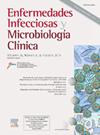2008 - 2022年长春地区医院剖宫产手术部位感染监测
IF 2.6
4区 医学
Q3 INFECTIOUS DISEASES
Enfermedades infecciosas y microbiologia clinica
Pub Date : 2025-01-13
DOI:10.1016/j.eimc.2024.07.014
引用次数: 0
摘要
背景VINCat计划的重点是监测附属医院剖腹产手术(CS)中的手术部位感染(SSI)。SSI 累计发生率的分析分为三个 5 年期(1-3 期)。SSI根据美国国家医疗安全网络(NHSN)的分类进行定义。SSI 监测按照 VINCat 计划制定的方法进行。结果从 2008 年到 2022 年,34 家医院共调查了 36,387 例 CS:第 1 期为 13502 例,第 2 期为 12985 例,第 3 期为 9900 例。平均年龄为 33 岁。总体而言,SSI 发生率从第 1 期的 3.81% 降至第 3 期的 2.66%(rho = -0.838;p < 0.001)。浅表 SSI 从第 1 期的 3.1%降至第 3 期的 2.15%(rho = -0.795;p <;0.001)。器官间的 SSI 感染率在三个时期保持一致,均为 0.27(rho = -0.092;p = 0.745)。58.9%的感染进行了培养。最常发现的微生物是金黄色葡萄球菌(20.64%)、凝固酶阴性葡萄球菌(CoNS)(13.52%)和大肠埃希菌(11.27%)。73.76%的手术采用了适当的抗生素预防措施。本文章由计算机程序翻译,如有差异,请以英文原文为准。
Surveillance of surgical site infections among caesarean section in VINCat hospitals: Results from 2008 to 2022
Background
The VINCat programme focuses on monitoring surgical site infections (SSI) in caesarean sections (CS) performed across affiliated hospitals.
Methods
The study included CS performed from 2008 to 2022, with a follow-up of 30 days after the intervention. The analysis of cumulative incidence rate of SSI was stratified into three 5-year periods (Periods 1–3). SSI was defined according to the National Healthcare Safety Network (NHSN) classification. SSI surveillance was carried out in accordance with the methodology established by the VINCat programme.
Results
From 2008 to 2022, 36,387 CS were surveyed at 34 hospitals: 13,502 in Period 1, 12,985 in Period 2 and 9900 in Period 3. The mean age was 33 years. Overall, SSI incidence fell from 3.81% in Period 1 to 2.66% in Period 3 (rho = −0.838; p < 0.001). Superficial SSI decreased from 3.1% in Period 1 to 2.15% in Period 3 (rho = −0.795; p < 0.001). The rate of organ-space SSI remained consistent across all three periods, maintaining a rate of 0.27 (rho = −0.092; p = 0.745). Culture was performed in 58.9% of infections. The microorganisms most frequently identified were Staphylococcus aureus (20.64%), Coagulase-negative staphylococci (CoNS) (13.52%), and Escherichia coli (11.27%). Antibiotic prophylaxis was appropriate in 73.76% of the procedures.
Conclusions
Appropriate monitoring of post-CS SSI rates allows the implementation of preventive measures to reduce their incidence.
求助全文
通过发布文献求助,成功后即可免费获取论文全文。
去求助
来源期刊
CiteScore
2.10
自引率
8.00%
发文量
194
审稿时长
29 days
期刊介绍:
Hoy está universalmente reconocida la renovada y creciente importancia de la patología infecciosa: aparición de nuevos agentes patógenos, de cepas resistentes, de procesos con expresión clínica hasta ahora desconocida, de cuadros de una gran complejidad. Paralelamente, la Microbiología y la Infectología Clínicas han experimentado un gran desarrollo como respuesta al reto planteado por la actual patología infecciosa. Enfermedades Infecciosas y Microbiología Clínica es la Publicación Oficial de la Sociedad Española SEIMC. Cumple con la garantía científica de esta Sociedad, la doble función de difundir trabajos de investigación, tanto clínicos como microbiológicos, referidos a la patología infecciosa, y contribuye a la formación continuada de los interesados en aquella patología mediante artículos orientados a ese fin y elaborados por autores de la mayor calificación invitados por la revista.

 求助内容:
求助内容: 应助结果提醒方式:
应助结果提醒方式:


